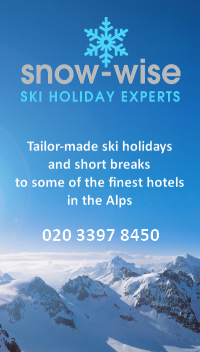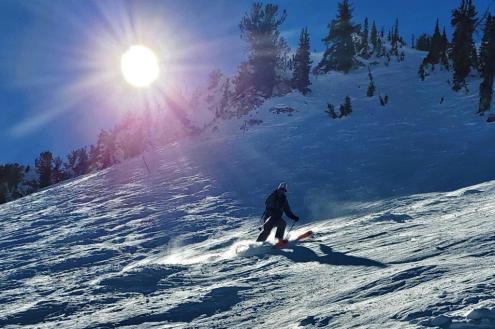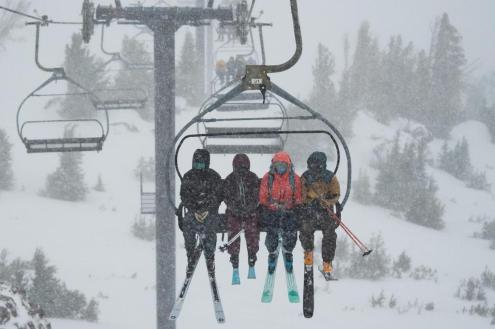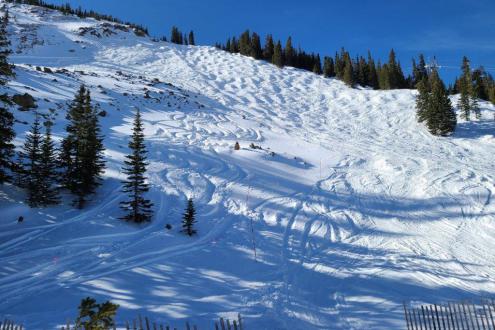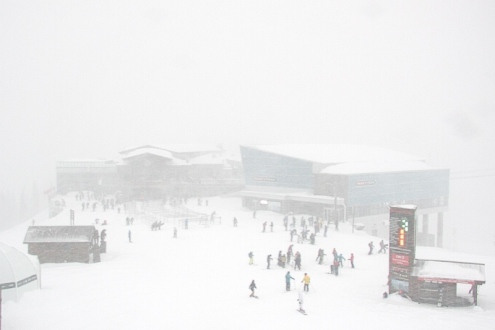Who got the most snow in North America in 2021-22?
Guest feature by Tony Crocker, 23 January 2023
2021-22 was a substantially below average snowfall season (86%) in North America's ski areas, aside from the Pacific Northwest and some of western Canada. It was a moderate La Niña season, regionally very similar to 2020-21. However, as December was the big snow month with most areas in full operation for the holiday season, 2021-22 was qualitatively a better season than 2020-21.
2021-22’s snow deficit was nearly all due to an extreme, widespread dry spell from mid-January through mid-February. La Niña storms concentrated upon the Pacific Northwest in April.
California
A late October atmospheric river dropped up to 20cm of rain below 3,000 meters before dumping a metre of heavy snow. Mammoth opened 22% of its terrain on 29 October, with Palisades Tahoe (formerly known as Squaw Valley) opening 13% but only for three days.
It was so warm and dry in November that only Mammoth remained open. No Tahoe areas preserved or made enough snow to open until early December. During the fortnight before Christmas, the Sierra then got pounded with 3m of snow, with a further 1-2m falling during the holiday week.
January to March was the driest on record in the Sierra, with zero snow in January and about a metre in February/March combined. Spring conditions emerged by early February.
In mid-April, storm totals ranged from 1m at Mammoth to 2m north-west of Lake Tahoe. Palisades closed on 30 May and Mammoth on 5 June.
Overall, California’s season saw 77% of its average snowfall. Heavenly’s upper site got 5.6m (57%) and Kirkwood 7.6m (65%). Palisades’ (formerly Squaw Valley) upper site (9.1m, 86%) led the region, while Mammoth got 6.6m (74%).
Utah
Utah's season saw 65% of its average snowfall, with record low snowfall of well under a metre in November, January and February. Fortunately, the Cottonwood Canyon areas had 4 metres of snow in December, while other areas got 1.5-2.5 metres. March and April were average.
Alta led the state with 10.2m (78% of its long-term average), while Park City got 3.8m (51%) and Snowbasin 6.0m (75%). Snowbird got 8.8 m (70%) and closed on 15 May.
Colorado (and New Mexico)
Colorado’s Front Range/I-70 resorts had, on average, one third of their ski area’s open at Christmas, with one metre of December snow following a below average November. They were over half open by New Year’s, with about 70cm falling during the holiday week, and then fully open by mid-January with another 70cm. February saw less than half its average snowfall, but the season was close to average from mid-February onwards, ending up at 78% of normal.
Snowfall totals were 7.7m in Winter Park (88% of its long-term average). 6.6m in Breckenridge (74%), and 7.1m in Vail (79%). A-Basin had 6.4m (81%) and remained open to 5 June.
The Southwest was hit harder in December, with 1-2m falling during the fortnight before Christmas and 1m+ during the holiday week. Aside from an isolated early February storm delivering 80cm in Wolf Creek and New Mexico, the next month and a half saw less than half its average snowfall. Two metres of snow fell between mid-February and mid-March, followed by a mostly dry spring, leaving the season at 88% of its long-term average.
Snowfall totals were 9.9m in Wolf Creek (99%), 6.7m in Aspen Highlands (103%) and 5.2m in Taos (82%).
The Northeast
The Northeast had another poor Christmas, with ski areas less than half open due to excessive December rain. Skiing improved through January with cold weather and 1m+ of snow. February and March had average snowfall in New England, though each month saw a week where conditions degraded due to rain.
Eastern Canada fared better, with less rain and more snow, remaining continuously in full operation into mid-April.
Overall, the season saw 82% of its long-term average snowfall in the Northeast, with Stowe seeing 6.1m (81%), Killington 5.5m (91%) and Sugarloaf 2.5m (58%). In Canada, Le Valinouet led the region with 9.2m (132%) while Le Massif had 6.8m (112%).
US Northern Rockies
The US Northern Rockies had less than a metre of snow through early December, but then saw 2-3m during the rest of the month and up to 1m during the first half of January. Most areas had less than half a metre during the ensuing dry month, so widespread spring conditions emerged.
Snowfall was then close to normal from late February through mid-March, but early spring was mostly warm and dry. On average, 1.5m fell in the second half of April after most areas had closed, with the season finishing at 85% of its long-term average.
Grand Targhee led the region with 9.8m (83%), while Jackson Hole had 7.9m (84%) and Sun Valley 3.9m (80%). Near the Canadian border, Whitefish had 6.6m (80%) and Schweitzer 7.3m (101%).
Interior Western Canada
Interior Western Canada was the only region with a snowy November (with 1.5 to 3m) and enjoyed similar abundant snow in December, and nearly a metre during the first half of January. Snowfall was then about half normal through the end of February, with occasional rain in lower areas. March and April were then close to average, so the season ended at 111% of its long-term average.
Revelstoke led the region with 10.4m (114%), while Big White had 6.9m (95%), Fernie 8.6m (92%) and Lake Louise 6.4m (145%).
Pacific Northwest
The Pacific Northwest had a very stormy early season, but most of the November storms generated rain, except in the Whistler alpine (i.e. at higher altitude). December saw 3-5m of snowfall, followed by 1.5m during the first week of January. It then rained at all but the highest elevations during the second week of January, leaving variable conditions over the next month, with only a further 40cm falling during that time.
Snowfall averaged 1m in late February, but March saw mostly spring conditions, with about 1m of snow over the entire month. Winter returned in April with 2-4m of snow and a season total 102% of normal.
Mount Baker led North America in snowfall with 16.2m (92%), while Whistler had 10.7m (101%). Crystal Mountain had 10.0m (95%) and remained open to 12 June, while Mount Bachelor had 10.0m (102%) and was open to 30 May.
Tony Crocker is an award-winning snow-sports journalist
and founder of www.bestsnow.net - the definitive guide to weather
and snowfall patterns in North American Ski resorts.
Read more about him here
If you enjoy reading our updates - please feel free to support us:


